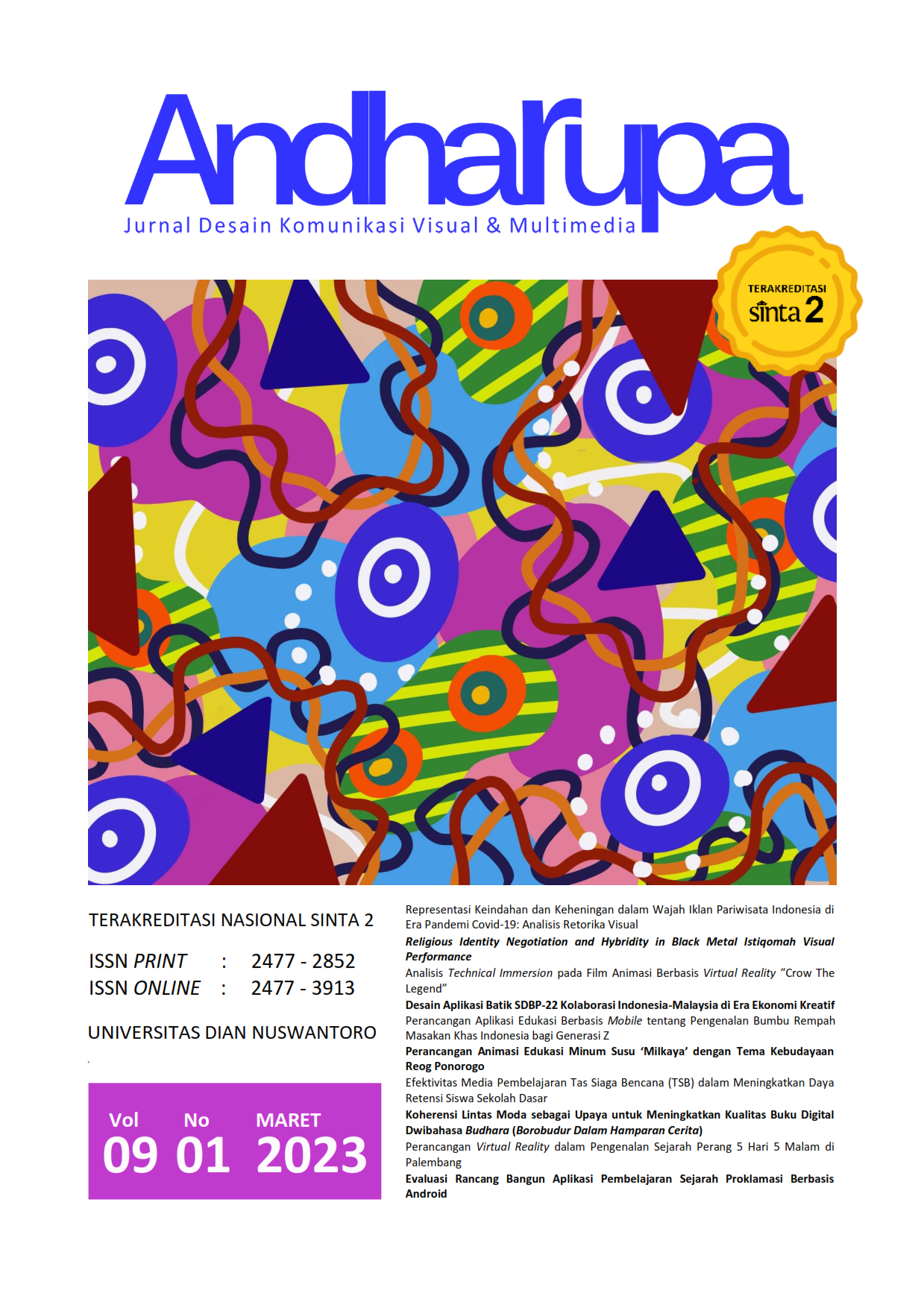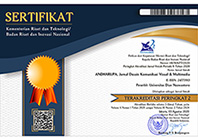Perancangan Aplikasi Edukasi Berbasis Mobile tentang Pengenalan Bumbu Rempah Masakan Khas Indonesia bagi Generasi Z
DOI:
https://doi.org/10.33633/andharupa.v9i01.7584Abstract
AbstrakIndonesia adalah negara yang memiliki keragaman budaya yang tinggi, terutama pada sektor pengenalan rempah-rempah. Seiring dengan perkembangan teknologi dan globalisasi pada bidang kuliner, membuat generasi muda saat ini khususnya generasi Z, sulit dalam mengidentifikasi dan mengklasifikasi serta mengenal rempah-rempah masakan khas Indonesia. Tujuan penelitian ini mencakup: memperkenalkan kembali budaya rempah masakan khas Indonesia, mengenalkan keanekaragaman hayati yang dimiliki Indonesia kepada generasi Z, dan memberikan solusi bagi masalah masyarakat dalam proses memasak yang kerap sulit sekali membedakan jenis rempah atau bahkan hingga tertukar satu sama lainnya. Metode pengumpulan data dilakukan melalui kuesioner, wawancara, observasi, dan kajian literatur, serta metode penelitian desain yang digunakan menggunakan pendekatan Design Thinking. Hasil penelitian berupa rancangan prototipe berbasis aplikasi mobile dengan konten bahan ajar yang dikemas dalam aplikasi dengan visualisasi unsur warna, tipografi dan ilustrasi yang informatif dan menarik. Manfaat yang dihasilkan adalah terciptanya media DKV yang tepat bagi proses pengenalan rempah masakan sebagai warisan budaya Indonesia. Selain kemudahan dalam penggunaannya dan diharapkan media ini dapat menjadi solusi metode edukasi untuk bidang lainnya. Kata Kunci: aplikasi mobile, budaya, edukasi, kuliner, rempah Abstract Indonesia is a country that has high cultural diversity, especially in the spice introduction sector. Along with technological developments and globalization in the culinary field, today's young generation, especially generation Z, is starting to find it challenging to identify and classify and recognize Indonesian special spices. The research objectives include: reintroducing the spice culture of Indonesian things, introducing biodiversity which Indonesia owns for generation Z, and providing solutions to problems that often occur among the public in the cooking process, which is often very difficult to distinguish the types of spices or even to the point of being confused with one another. In addition, it is hoped that Generation Z can participate in developing business ideas in the culinary sector as a form of support and an effort to advance tourism in Indonesia through the culinary industry. The research results are mobile application-based prototype designs with teaching material content packaged in applications with informative and attractive visualization of colour elements, typography, and illustrations. Data collection methods were carried out through questionnaires, interviews, observations, literature reviews. The design research methods using the Design Thinking approach. The benefits resulting from this research are to design visual communication media that are appropriate for introducing cooking spices as an Indonesian cultural heritage, as well as for ease of use and are expected to be a solution to educational methods for other fields. Keywords: culinary, culture, education, mobile application, spicesReferences
Babich, N. (2017, November 29). Prototyping 101: The Difference between Low-Fidelity and High-Fidelity Prototypes and When to Use Each. Adobe Blog. https://blog.adobe.com/en/publish/2017/11/29/prototyping-difference-low-fidelity-high-fidelity-prototypes-use
BKPM. (2021, December 18). Indonesia Spice Up the World | BKPM. News. https://www.bkpm.go.id/en/publication/detail/news/indonesia-spice-up-the-world
Dam, R. F., & Siang, T. Y. (2022). Affinity Diagrams: How to Cluster Your Ideas and Reveal Insights. UX Courses. https://www.interaction-design.org/literature/article/affinity-diagrams-learn-how-to-cluster-and-bundle-ideas-and-facts
Dwinawan. (2018, September 2). Memahami User Flow. Medium. https://medium.com/insightdesign/memahami-user-flow-d8f97d30816
Fatoni, R. A. (2021). Pengenalan Game Edukasi Wudhu Berbasis Android Dengan Konsep Gamifikasi. Jurnal Ilmu Data, 1(1).
Fessenden, T. (2021, April 11). Design Systems 101. Design Process, Strategy, Branding. https://www.nngroup.com/articles/design-systems-101/
Firmansyah, H. P., Sulistiowati, & Kartikasari, P. (2018). Perancangan UI/UX Pelayanan Otomasi Badan Perpustakaan dan Kearsipan Jawa Timur dengan Menggunakan Metode Heuristik Webuse. JSIKA, 07(04), 1–7.
Gayatri, G., Rusadi, U., Meiningsih, S., Mahmudah, D., Sari, D., & Cahyo Nugroho, A. (2015). Digital Citizenship Safety Among Children and Adolescents in Indonesia. Jurnal Penelitian Dan Pengembangan Komunikasi Dan Informatika, 6(1), 1–16.
Gibbons, S. (2018, December 9). Journey Mapping 101. Web Article. https://www.nngroup.com/articles/journey-mapping-101/
Ikorasaki, F., Arwa, K., & Hrp, N. A. (2022). Rancang Bangun Aplikasi Pengenalan Masakan Nusantara Berbasis Android. Blend Sains - Jurnal Teknik, 1(1), 48–54.
Indonesia Expat. (2019, December 29). Top Indonesian Spices & Herbs to Keep in Your Pantry. News. https://indonesiaexpat.id/featured/top-indonesian-spices-to-keep-in-your-pantry/
Javarapedia. (2021, March 23). Archipelago Spice Collection: Indonesia's Legacy to Spice Up the World. News. https://javara.co.id/archipelago-spice-collection-indonesia/
Khamadi. (2015). Analisis Tampilan Visual Game Super Mario Bros dalam Kajian Persepsi Visual sebagai Dasar Pengembangan Konsep Visual Game. Andharupa, 01(02), 98–109.
Mahfunda, R. (2019, November 5). Apa itu Competitor Analysis? Medium. https://medium.com/design-jam-indonesia/apa-itu-competitor-analysis-a1f22c1f136c
Möller, O. (2012, September 11). The Kipling method. Method. https://projectofhow.com/methods/the-kipling-method/
Nufika, A. (2019). Suitability Analysis of SpicesToward Ingredients and Processing Methods in Indonesian Food. http://etd.repository.ugm.ac.id/
Nurfitri, A., Aknuranda, I., & Muslimah Az-Zahra, H. (2019). Pemetaan User Journey untuk Sistem Informasi Praktik Kerja Lapangan Fakultas Ilmu Komputer Universitas Brawijaya. Jurnal Pengembangan Teknologi Informasi Dan Ilmu Komputer, 3(8), 7542–7548. http://j-ptiik.ub.ac.id
Pamungkas, D. P. (2016). Analisis Competitive Force dan Competitive Strategy Sistem Informasi Kuliner di Indonesia (Studi Kasus: Kulina.id). Jurnal Electronics, Informatics, and Vocational Education (ELINVO), 1(2), 118–127.
Pontis, S. (2015, June 4). Design Thinking Revised. Web Article. https://sheilapontis.com/2015/06/04/design-thinking-revised/
Purnomo, D. (2017). Model Prototyping Pada Pengembangan Sistem Informasi. JIMP-Jurnal Informatika Merdeka Pasuruan, 2(2).
Puspita, R. (2020). Pengembangan Prototipe Aplikasi Community Aggregator Beskem dengan UCD Menggunakan Balsamiq Mockup dan Figma [Skripsi]. Universitas Islam Negeri Syarif Hidayatullah.
Rahman, F. (2019). “Negeri Rempah-Rempah” dari Masa Bersemi Hingga Gugurnya Kejayaan Rempah-Rempah. Patanjala: Jurnal Penelitian Sejarah Dan Budaya, 11(3), 347.
Rastati, R. (2018). Media Literasi bagi Digital Natives: Perspektif Generasi Z di Jakarta. Kwangsan: Jurnal Teknologi Pendidikan, 6(1), 60–73.
Rosala, M. (2021, January 17). Using "How Might We" Questions to Ideate on the Right Problems. Web Article. https://www.nngroup.com/articles/how-might-we-questions/
Veal, R. (2022, December 6). How to Define a User Persona. CF Blog. https://careerfoundry.com/en/blog/ux-design/how-to-define-a-user-persona/
Wiedarti, P. (2005). Kontribusi Metode Kawakita Jiro dalam Pemecahan Masalah. Jurnal Kependidikan Dan Kebudayaan, 02(52). http://www.foundationcoalition.org/
Downloads
Published
Issue
Section
License
Authors who publish with this journal agree to the following terms:
- Authors retain copyright and grant the journal right of first publication with the work simultaneously licensed under a Creative Commons Attribution License that allows others to share the work with an acknowledgment of the work's authorship and initial publication in this journal.
- Authors are able to enter into separate, additional contractual arrangements for the non-exclusive distribution of the journal's published version of the work (e.g., post it to an institutional repository or publish it in a book), with an acknowledgment of its initial publication in this journal.
- Authors are permitted and encouraged to post their work online (e.g., in institutional repositories or on their website) prior to and during the submission process, as it can lead to productive exchanges, as well as earlier and greater citation of published work (See The Effect of Open Access).















